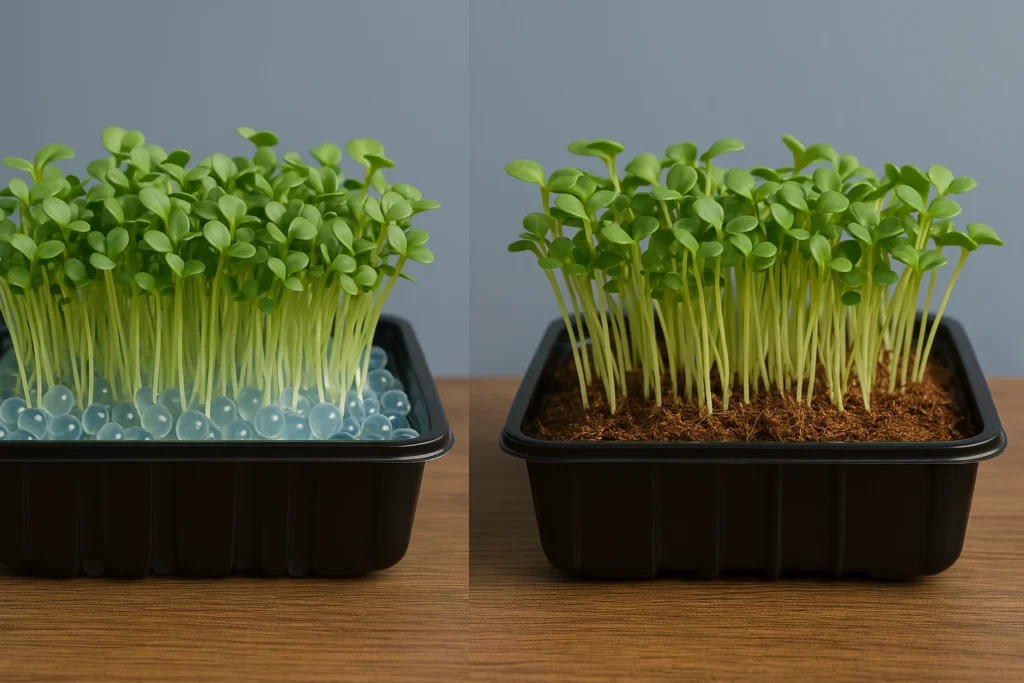Automated gardening setups have revolutionized the way we grow plants, offering a more hands-off approach to managing plants indoors. Microgreens, with their short growing cycles and relatively simple needs, are particularly well-suited for automation. Whether you are using automated watering systems, smart lighting, or climate control systems, automation can help maintain the ideal growing conditions for microgreens while saving time and effort.
But not all microgreens are created equal when it comes to automation. Some varieties thrive better in automated setups due to their growing habits, water requirements, and ability to adapt to controlled environments. In this article, we’ll explore which microgreens are the best candidates for automated growing systems and why they work well in such setups.
Why Microgreens Are Perfect for Automated Setups
Before we dive into which specific microgreens thrive in automated systems, it’s essential to understand why microgreens are ideal for this type of setup.
1. Fast Growth Cycle
Microgreens are typically harvested within 7 to 21 days, depending on the variety. This rapid growth makes them ideal for automated setups, as they don’t require long-term monitoring, and any issues with the system can be addressed quickly.
2. Space-Efficient
Microgreens require very little space, making them perfect candidates for small automated systems. Whether grown in vertical farming racks or hydroponic trays, their compact size allows them to thrive in controlled, automated environments without taking up too much room.
3. Consistent Environmental Needs
Microgreens have fairly consistent requirements for temperature, humidity, water, and light. This makes them well-suited for automation, as the system can be programmed to maintain these conditions with little variation, resulting in consistent, high-quality harvests.
4. Minimal Maintenance
Once set up, automated systems require minimal intervention. Microgreens, due to their quick growth cycle, benefit from this aspect, allowing growers to automate watering, lighting, and even temperature adjustments with ease.
Microgreens That Thrive Best in Automated Setups
1. Radish Microgreens
Radish microgreens are one of the most popular and easiest varieties to grow in automated setups. They grow quickly and are known for their spicy, peppery flavor.
Why They Thrive:
- Fast Growth Cycle: Radish microgreens typically take 5 to 10 days to grow, making them ideal for quick harvests in an automated system.
- Tolerance to Light and Water Fluctuations: Radishes can adapt well to varying light and watering schedules, making them perfect for an automated watering system.
- Compact Growth: These microgreens grow in a dense, compact manner, allowing them to fit easily into automated growing trays or vertical farms.
Automation Tips:
- Set your automated watering system to provide consistent moisture but avoid overwatering. Radish microgreens do not like to sit in water.
- Use LED grow lights on a 12-16 hour cycle to maintain a healthy growth rate and ensure the plants receive the optimal amount of light.
2. Sunflower Microgreens
Sunflower microgreens are another popular choice for automated systems. They are well-known for their nutty flavor and tender leaves. These microgreens are a favorite for their versatility in salads, sandwiches, and even smoothies.
Why They Thrive:
- Robust Growth: Sunflower microgreens grow relatively quickly, taking 7 to 10 days to reach harvestable size.
- Resilient to Environmental Control: They handle automated environments well, tolerating moderate fluctuations in light and humidity.
- Dense Growth: Sunflower shoots grow densely, which makes them a good choice for vertical hydroponic systems or automated trays with limited space.
Automation Tips:
- Automated lights with a full-spectrum spectrum are best for sunflower microgreens, as they need both blue and red light for optimal growth.
- Ensure consistent moisture without waterlogging. An automated irrigation system that uses timed drip watering or misting works best.
3. Pea Shoots
Pea shoots are another variety that thrives in automated setups. Known for their sweet, fresh taste and delicate texture, pea shoots grow quickly and are easy to manage with automation.
Why They Thrive:
- Rapid Growth: Pea shoots mature in about 7 to 14 days, making them a great choice for systems designed for quick turnaround crops.
- Low Light Requirements: Pea shoots don’t require intense lighting to thrive, and automated systems can easily control light intensity, allowing for optimal growth.
- Flexible Watering Needs: Pea shoots grow well in both soil-based and hydroponic systems. Automated systems can deliver consistent water without overwatering.
Automation Tips:
- Use an automated lighting system with a 12-14 hour cycle to provide adequate light for pea shoots.
- Consistent moisture is key, so consider setting up an automated misting system or hydroponic drip system that keeps the growing medium moist but not soggy.
4. Arugula Microgreens
Arugula microgreens are known for their spicy, mustard-like flavor. These microgreens grow quickly, are easy to manage, and adapt well to automated systems.
Why They Thrive:
- Fast Growth: Arugula microgreens take 7 to 14 days to grow, making them well-suited for automated systems that require a fast crop turnaround.
- Compact Growth: Arugula microgreens are small and compact, making them a perfect fit for small automated growing systems, such as vertical farms.
- Tolerance to Different Conditions: Arugula microgreens can thrive in hydroponic or soil-based systems and can adjust well to controlled environmental conditions.
Automation Tips:
- Use an automated grow light system with a 12-hour light cycle to promote strong leaf growth without leggy stems.
- Keep the growing medium consistently moist but ensure good drainage to prevent waterlogging.
5. Mustard Microgreens
Mustard microgreens, like their radish cousins, are known for their spicy and peppery flavor. These microgreens are easy to grow and do well in automated systems.
Why They Thrive:
- Quick Growth: Mustard microgreens typically take 5 to 10 days to mature, making them ideal for automated systems that allow for frequent harvests.
- Compact Size: They grow in dense clumps, which makes them ideal for hydroponic systems or automated trays that have limited space.
- Tolerance to Automation: Mustard microgreens tolerate a range of light and moisture conditions, making them adaptable to various automated setups.
Automation Tips:
- Timed irrigation is key to ensuring that mustard microgreens don’t dry out or become waterlogged. Automated drip systems work well for this variety.
- Smart lighting that includes both blue and red light wavelengths will encourage healthy leaf growth and vibrant color.
Automation Tools to Optimize Microgreen Growth
To ensure that your automated microgreen setup is as efficient as possible, consider using the following tools:
1. Automated Watering Systems
Automated watering systems, such as drip irrigation, misting systems, and hydroponic wicks, help deliver consistent moisture to your microgreens without the need for constant manual intervention. Many of these systems can be timed or connected to sensors that detect soil moisture, ensuring that your microgreens receive the right amount of water at the right time.
2. Smart LED Grow Lights
Investing in smart LED grow lights that offer full-spectrum lighting is essential for promoting healthy microgreen growth. These lights can be programmed to run on specific cycles (e.g., 12-16 hours of light) and can be adjusted for intensity to suit the needs of different microgreen varieties.
3. Climate Control Systems
Automated climate control systems can help maintain ideal temperature and humidity levels for your microgreens. Most microgreens thrive in temperatures between 65°F to 75°F (18°C to 24°C) with moderate humidity levels, which can be easily controlled using automated systems.
4. Smart Sensors and Monitoring
Using IoT sensors or smart monitoring devices can help you keep track of environmental conditions like temperature, humidity, and moisture levels. These sensors can alert you when conditions deviate from the optimal range, allowing you to take corrective action before it impacts your crop.
Conclusion
Microgreens are an ideal crop for automated setups due to their fast growth cycles, space efficiency, and minimal maintenance requirements. The varieties that thrive best in these systems are typically those that grow quickly, have consistent environmental needs, and can adapt to different watering and lighting conditions.
Some of the best microgreens for automated setups include radish, sunflower, pea shoots, arugula, and mustard microgreens. By using automated watering, lighting, and climate control systems, you can ensure healthy, consistent, and high-quality microgreen crops with minimal effort.
With the right tools and setup, you can take advantage of automation to grow a variety of flavorful, nutrient-dense microgreens year-round, all with little intervention needed.
Frequently Asked Questions
1. Can all microgreens be grown in automated systems?
Most microgreens can thrive in automated setups, but varieties that grow quickly and require consistent moisture and light, like radish, sunflower, and pea shoots, tend to do best.
2. What’s the best type of automated watering system for microgreens?
Drip irrigation and hydroponic systems are highly recommended for microgreens, as they provide consistent moisture without overwatering the plants.
3. How much light do microgreens need in automated systems?
Microgreens typically need 12 to 16 hours of light per day. Full-spectrum LED grow lights are ideal for providing the necessary light for both vegetative growth and flavor development.
4. Can I grow microgreens without automation?
Yes, you can grow microgreens manually, but automation helps optimize growth and reduces the amount of time and effort required for care.
5. What tools do I need for an automated microgreen setup?
Key tools include automated watering systems, smart LED grow lights, climate control systems, and monitoring devices. These tools help maintain the ideal environment for your microgreens.
4o mini


